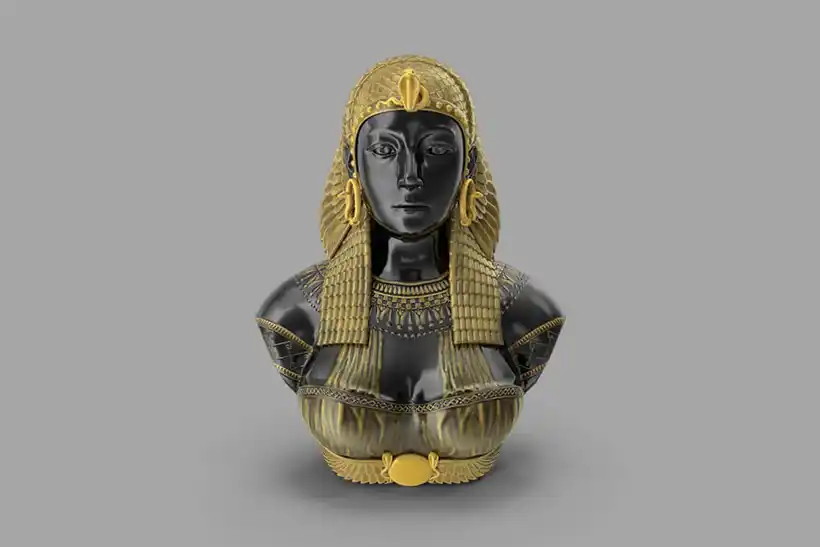
1. Queen Cleopatra was not an Egyptian
Queen Cleopatra was born (early 69 BC) in Egypt, however her ancestors came from Macedonia, being one Alexander the Great’s commanders. After Death of alexander in 323 B.C., Egypt was controlled by Ptolemy, who founded a dynasty of Greek-speaking kings that stretched over three centuries. Although she was not of Egyptian origin, Cleopatra adopted several of the country’s traditional values and became the first person of the Ptolemaic dynasty to learn Egyptian.
2. Both of her brothers were married to her
Monarchs of the Ptolemaic empire wedded inside the household family members in terms of maintaining the integrity of their race and maintaining control. Many of Cleopatra’s forefathers married sisters or relatives, thus her parents were very certainly siblings. Cleopatra engaged each one of her younger siblings at various periods throughout her rule, who together acted as her husband and rulers.
3. Queen Cleopatra always made grand and dramatic entrance
Cleopatra was known for her lavish clothing and spectacular entrances, which she utilized to enhance her royal reputation and attract over core allies. She snuck herself into Julius Caesar’s personal chambers by wrapping herself in carpet in 48 BCE. The sight of the young queen charmed Caesar, and the two quickly established political friendship and companions.
4. Queen Cleopatra had established A drinking club
The friendship between Cleopatra and Antony had personal and economic benefits. Cleopatra gave Antony accessibility to Egypt’s wealth treasures and manpower, while Antony supported her to defend her throne. Apart from all of that, they remained incredibly attracted of one another. They allocated time for each other in winter of 41-40 BCE in Egypt, whereupon they established their personal drinking club called as the “Inimitable Livers.” The participants took part in complex games and tournaments as well as regular banquets and alcoholic binges.
5. Queen Cleopatra took baths in warm donkey milk
Cleopatra was known by her exceptional charm and wisdom, as per historical sources. These characteristics gave fame and popularity across Egypt. Sources claimed that she would always have to follow a particular beauty routine to retain her light skin and attractive features.
This treatment plan featured a variety of therapies as well as a rigorous eating plan. Taking a bath in warm donkey milk everyday was one of these ways. It would boost her skin tone and softness. Scholars have still yet to uncover evidence to support these claims, but they assume that soon after Cleopatra’s death, the Romans Queen Poppaea established them as a common bathing routine.
6. The ancient tomb of Queen Cleopatra was never discovered
The burial of Cleopatra has been undiscovered for thousands of years, as per Egyptologists. They also claimed that it is exceedingly unlikely to be found during this time period. Some studies claim that the tomb might be located in the Ptolemaic remains in Alexandria, Egypt. However, because there is no contemporary evidence to support this notion, it remains a speculation.
Following her demise, the whereabouts of Cleopatra’s tomb has remained one of the most fascinating issues for not only Egyptologists but also the general population across the world. Have you had any idea where it could be?
7. Cleopatra was effective in seducing her lovers in order to improve Egypt’s diplomatic alliances
Cleopatra made such an impact on Mark Antony when she was 14, that he instantly fell in love with her. Throughout this period, Mark Antony was a part of ‘Gabinius’ army and was funded by Cleopatra’s father. As a result, she developed a passion for him in order to acquire a military for herself throughout her reign.
Julius Caesar and Cleopatra started a relationship in 48 BC, although Julius was her brother’s and husband’s ward. Cleopatra recognized the importance of maintaining a connection with Caesar. Caesar stayed faithful to her throughout their partnership, and she publicly claimed about her romance with him.
8. Myth of her beauty
Cleopatra is frequently shown in art and movies as an exquisite seductress. However, there is information that she wasn’t quite as physically attractive as some of you may believe. Her profile appears on ancient Egyptian currencies, and that she had a masculine face and a chiselled chin. Queen Cleopatra is said to have fought hard to maintain control over how she was viewed by the people. Her depiction on Egyptian currencies was a method for her to look more manly, defining her strength and right to govern.
9. Cleopatra was a brilliant and intelligent woman
Though we may not know how gorgeous Cleopatra was, there seems to be one thing we do know about her: she was extremely bright and clever.
Despite Roman disinformation portraying her as just a lustful seductress, Cleopatra is said to have been a linguist. She spoke at least twelve languages. She studied physics, math, philosophy, and public speaking.
According to the Arab scholar Al-Masudi (896–956 CE), Cleopatra was a scholar and a philosopher. He noted that she “raised up the rankings of intellectuals and relished their company.” He further stated she published books on medication, charm, and beautification. She recommended cures for loss of hair and flaking in a piece titled Cosmetics.
10. Her death is a mystery
After losing the historic sea war at Actium to Octavian’s armies, Cleopatra and Antony reportedly took their respective deaths in 30 BCE. Although it is largely known that Antony killed himself by stabbing himself in the chest, Cleopatra’s manner of suicide is disputed. Some historians claim she killed herself by luring “asp”—a snake or Egyptian cobra—to strike her hand, while others disagree. Cleopatra had known for carrying a lethal poison under her hair clips, and many academics today believe she killed herself with a pin coated in a strong toxin.



